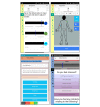Developing and Evaluating JIApp: Acceptability and Usability of a Smartphone App System to Improve Self-Management in Young People With Juvenile Idiopathic Arthritis
- PMID: 28811270
- PMCID: PMC5575419
- DOI: 10.2196/mhealth.7229
Developing and Evaluating JIApp: Acceptability and Usability of a Smartphone App System to Improve Self-Management in Young People With Juvenile Idiopathic Arthritis
Abstract
Background: Flare-ups in juvenile idiopathic arthritis (JIA) are characterized by joint pain and swelling and often accompanied with fatigue, negative emotions, and reduced participation in activities. To minimize the impact of JIA on the physical and psychosocial development and well-being of young people (YP), it is essential to regularly monitor disease activity and side effects, as well as to support self-management such as adherence to treatment plans and engagement in general health-promoting behaviors. Smartphone technology has the potential to engage YP with their health care through convenient self-monitoring and easy access to information. In addition, having a more accurate summary of self-reported fluctuations in symptoms, behaviors, and psychosocial problems can help both YP and health care professionals (HCPs) better understand the patient's condition, identify barriers to self-management, and assess treatment effectiveness and additional health care needs. No comprehensive smartphone app has yet been developed in collaboration with YP with JIA, their parents, and HCPs involved in their care.
Objectives: The objective of this study was to design, develop, and evaluate the acceptability and usability of JIApp, a self-management smartphone app system for YP with JIA and HCPs.
Methods: We used a qualitative, user-centered design approach involving YP, parents, and HCPs from the rheumatology team. The study was conducted in three phases: (1) phase I focused on developing consensus on the features, content, and design of the app; (2) phase II was used for further refining and evaluating the app prototype; and (3) phase III focused on usability testing of the app. The interview transcripts were analyzed using qualitative content analysis.
Results: A total of 29 YP (aged 10-23, median age 17) with JIA, 7 parents, and 21 HCPs were interviewed. Major themes identified as the ones that helped inform app development in phase I were: (1) remote monitoring of symptoms, well-being, and activities; (2) treatment adherence; and (3) education and support. During phase II, three more themes emerged that informed further refinement of the app prototype. These included (4) adapting a reward system to motivate end users for using the app; (5) design of the app interface; and (6) clinical practice integration. The usability testing during phase III demonstrated high rates of overall satisfaction and further affirmed the content validity of the app.
Conclusions: We present the development and evaluation of a smartphone app to encourage self-management and engagement with health care for YP with JIA. The app was found to have high levels of acceptability and usability among YP and HCPs and has the potential to improve health care and outcomes for this age group. Future feasibility testing in a prospective study will firmly establish the reliability, efficacy, and cost-effectiveness of such an app intervention for patients with arthritis.
Keywords: adolescent; juvenile idiopathic arthritis; mobile applications; qualitative research; self-management; smartphone; young adult.
©Ran A Cai, Dominik Beste, Hema Chaplin, Socrates Varakliotis, Linda Suffield, Francesca Josephs, Debajit Sen, Lucy R Wedderburn, Yiannakis Ioannou, Stephen Hailes, Despina Eleftheriou. Originally published in JMIR Mhealth and Uhealth (http://mhealth.jmir.org), 15.08.2017.
Conflict of interest statement
Conflicts of Interest: None declared.
Figures






References
-
- Vidqvist K, Malin M, Varjolahti-Lehtinen T, Korpela MM. Disease activity of idiopathic juvenile arthritis continues through adolescence despite the use of biologic therapies. Rheumatology (Oxford) 2013 Nov;52(11):1999–2003. doi: 10.1093/rheumatology/ket256. http://rheumatology.oxfordjournals.org/cgi/pmidlookup?view=long&pmid=238... - DOI - PubMed
-
- World Health Organization . WHO. Geneva, Switzerland: World Health Organization; 2001. [2017-08-10]. The second decade: improving adolescent health and development http://apps.who.int/iris/bitstream/10665/64320/1/WHO_FRH_ADH_98.18_Rev.1... 6sbe5gCX4.
-
- Webb K, Wedderburn LR. Advances in the treatment of polyarticular juvenile idiopathic arthritis. Curr Opin Rheumatol. 2015 Sep;27(5):505–10. doi: 10.1097/BOR.0000000000000206. http://europepmc.org/abstract/MED/26147756 - DOI - PMC - PubMed
Grants and funding
LinkOut - more resources
Full Text Sources
Other Literature Sources

